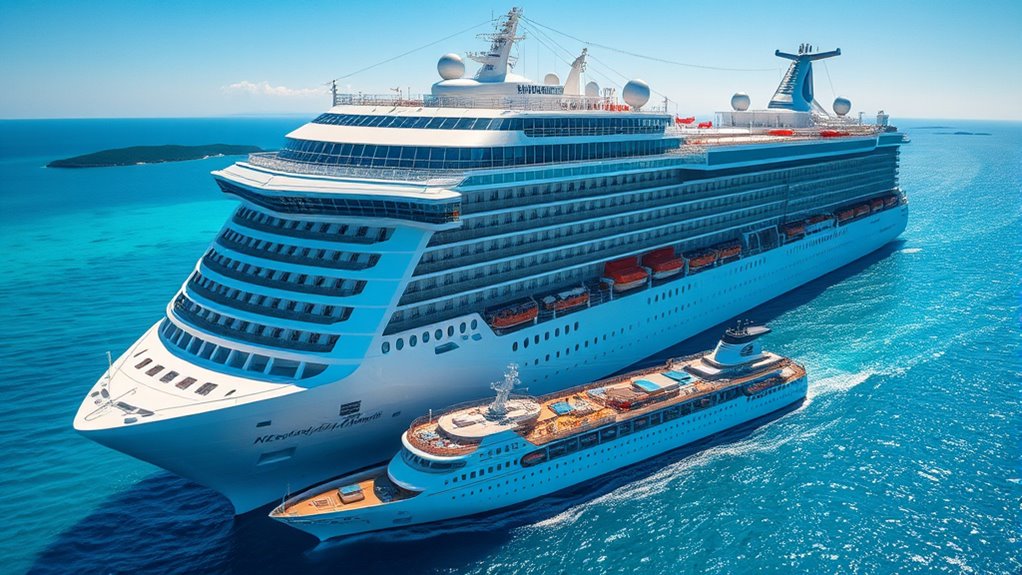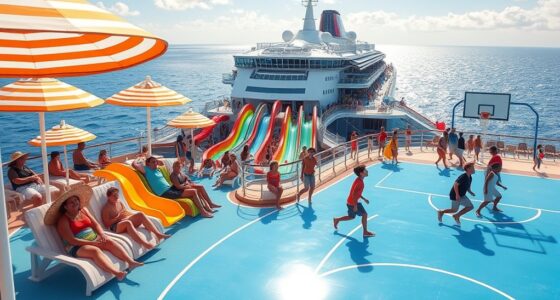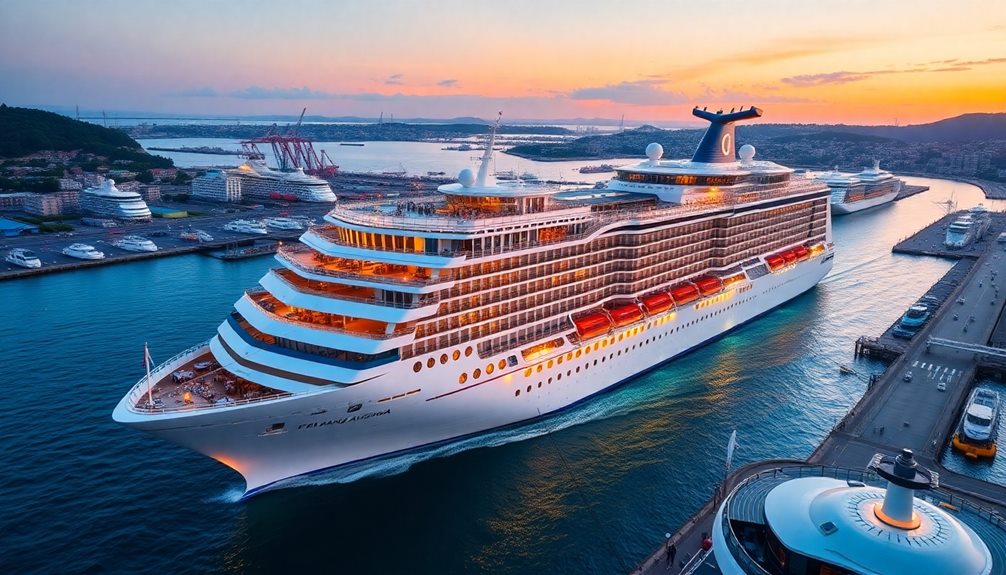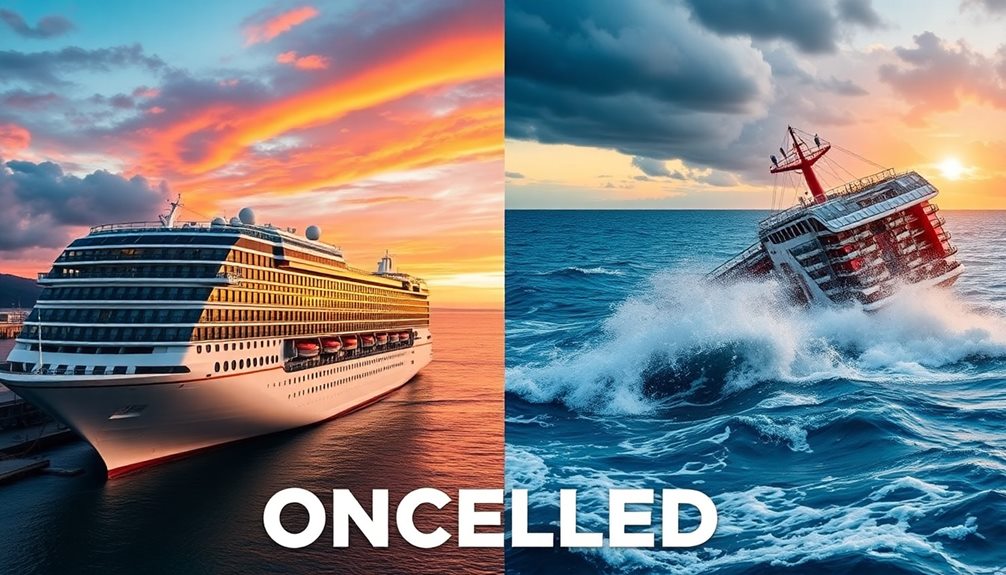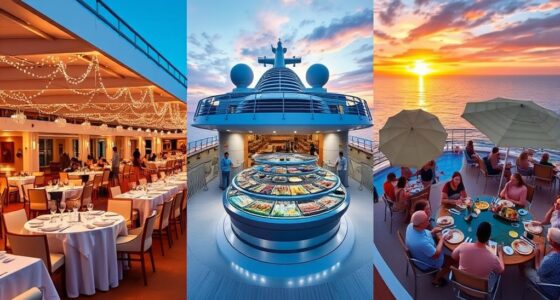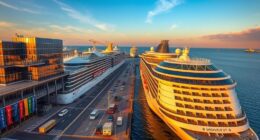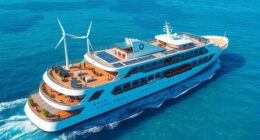Big ship cruises offer lively atmospheres with numerous onboard entertainment options, large groups, and fixed itineraries. Small ship cruises focus on intimate experiences, personalized service, and access to remote destinations, with flexible schedules and immersive excursions. If you prefer bustling venues and structured tours, a big ship might suit you. For peaceful exploration and authentic local encounters, a small ship could be ideal. Keep exploring to discover how these differences can shape your perfect cruise adventure.
Key Takeaways
- Big ships offer extensive onboard entertainment and amenities, while small ships prioritize exploration and cultural immersion.
- Small ships access remote ports more easily and dock closer to attractions, unlike larger ships with limited port options.
- Large ships feature lively atmospheres with crowded venues and scheduled activities, whereas small ships provide tranquil, personalized experiences.
- Family amenities and organized tours are prominent on large ships, while small ships focus on intimate excursions and adult-oriented experiences.
- Dining options are more varied on big ships with fixed schedules, while small ships emphasize local cuisine with relaxed, flexible dining.
Focus of the Cruise Experience
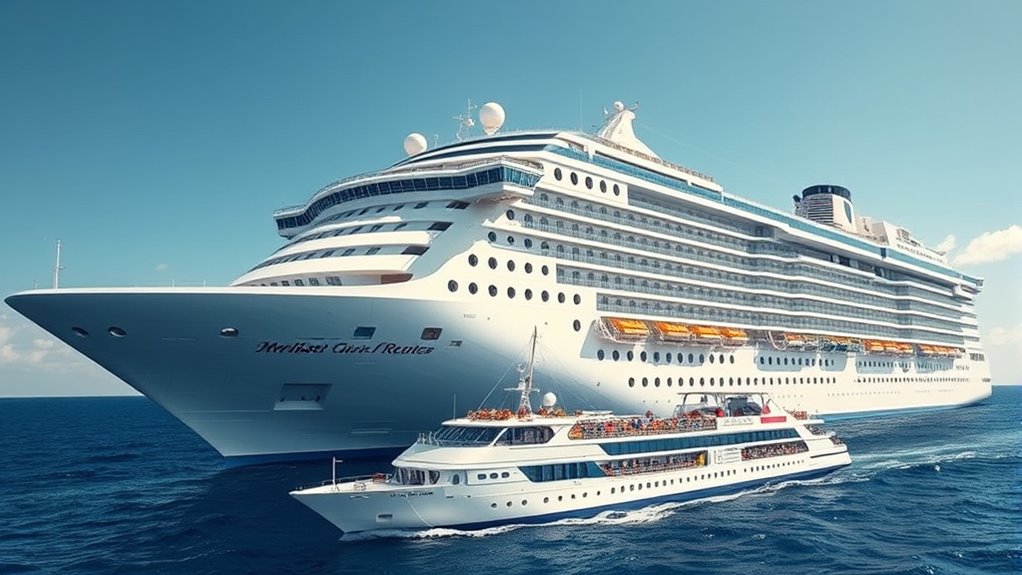
When choosing between big and small ship cruises, understanding their focus helps you find the experience that suits your preferences. Big ships prioritize onboard entertainment, with large pools, scheduled shows, and diverse dining options, creating a resort-like atmosphere. They often carry over 2,000 passengers, emphasizing social activities and leisure. Small ships, on the other hand, focus on exploration and cultural immersion, offering flexible itineraries tailored to passenger interests. With fewer than 1,000 passengers, small ships foster intimate experiences and access to remote destinations larger ships can’t reach. Additionally, the beach environment often influences the destinations and excursions available, enriching the overall experience. Smaller ships also tend to feature local culinary influences, allowing passengers to enjoy authentic regional flavors during their voyages. An important aspect of small ship cruises is their ability to provide personalized service, which enhances comfort and satisfaction. Smaller ships frequently offer exclusive excursions, giving travelers unique opportunities to explore off-the-beaten-path sites. Your overall experience depends on whether you seek lively entertainment and social interaction or authentic, immersive adventures. Knowing these differences helps align your expectations with the cruise’s core focus, ensuring a memorable journey that matches your preferences.
Atmosphere and Environment Onboard

On a big ship, you’ll find a lively, resort-like atmosphere with plenty of onboard entertainment and crowded venues. Small ships, on the other hand, offer a more intimate setting, often in quiet anchorages closer to nature and local communities. Your experience of the environment and scenic access varies greatly, shaping how connected and relaxed you feel throughout the journey. Additionally, asset division considerations during divorce can influence financial planning and your ability to enjoy your travels. Cultivating a growth mindset can help you adapt to different cruising experiences and make the most of each journey. Staying informed about market trends and potential opportunities can also enhance your overall travel planning and financial stability. Exploring remote experiences such as small ship cruises can provide a more personalized and immersive adventure, often in less crowded settings. Furthermore, understanding the environmental impact of different cruise sizes can guide you toward choices that align with sustainability goals and reduce your ecological footprint.
Intimacy and Connection
Small ships create an intimate atmosphere that makes it easy for you to connect with both the crew and fellow travelers. With fewer onboard guests, you enjoy a more personal experience, allowing for meaningful conversations and genuine engagement. The relaxed environment fosters authentic connections, often leading to friendships and memorable moments. The proximity to destinations enhances the sense of exclusivity, making you feel more involved in the journey. This setting encourages personalized service, where staff can better cater to your needs and preferences. Overall, small ships provide a peaceful, family-like vibe that promotes connection and reflection. Additionally, the atmosphere and environment onboard are designed to facilitate deeper bonds and shared experiences among guests, creating an environment that nurtures social connections and enhances overall satisfaction. The intimate setting also allows for more tailored excursions and activities, enriching your overall experience. Furthermore, the personalized service often results in higher guest satisfaction and a more memorable voyage. The smaller scale also means less crowding, which contributes to a more tranquil and relaxed environment that encourages meaningful interactions.
Onboard Activities and Atmosphere
The atmosphere onboard a cruise ship markedly shapes your overall experience, with large vessels bustling with energy and a wide variety of entertainment options, while small ships offer a more relaxed and intimate environment. On big ships, you’ll find extensive onboard activities like theaters, nightclubs, casinos, and large-scale shows that entertain thousands of guests simultaneously. The lively atmosphere creates a vibrant environment, perfect if you enjoy active entertainment and diverse amenities like waterslides and pools. In contrast, small ships foster a calm, refined atmosphere, emphasizing personalized service and social interactions. Their environment is more peaceful, with fewer organized activities but more opportunities for authentic connections and tranquil experiences. Your guest experience varies considerably based on the ship’s size, atmosphere, and available onboard entertainment. Additionally, onboard activities are often scheduled around the ship’s atmosphere, influencing how guests spend their time during the voyage. The ship size also affects the overall environment, with larger ships typically having more bustling settings and smaller ships offering a serene ambiance. The overall ambiance is also shaped by the design and decor, which can reflect either the lively or tranquil character of the vessel. A deeper understanding of consecration in spiritual practices can also enhance your appreciation of the dedicated spaces and rituals onboard ships that serve as places of reflection and renewal. Recognizing how the ship’s environment aligns with your personal preferences can significantly enhance your cruising experience.
Environment and Scenic Access
While large ships create a lively, resort-like atmosphere with indoor venues and limited ocean views, they often feel bustling and impersonal. Small ships, on the other hand, offer better scenic access to remote destinations and less-visited ports, allowing you to enjoy more authentic experiences. Because these vessels can dock closer to main attractions and natural sites, you spend less time in transit and more time exploring scenic spots. Their flexible itineraries often focus on immersive, natural scenery and off-the-beaten-path locations. The environment onboard small ships tends to be calmer and more intimate, providing a relaxed atmosphere that enhances your connection with the surroundings. If scenic access and authentic experiences matter to you, small ships deliver a more personal and scenic journey.
Accommodation Options and Dining Styles
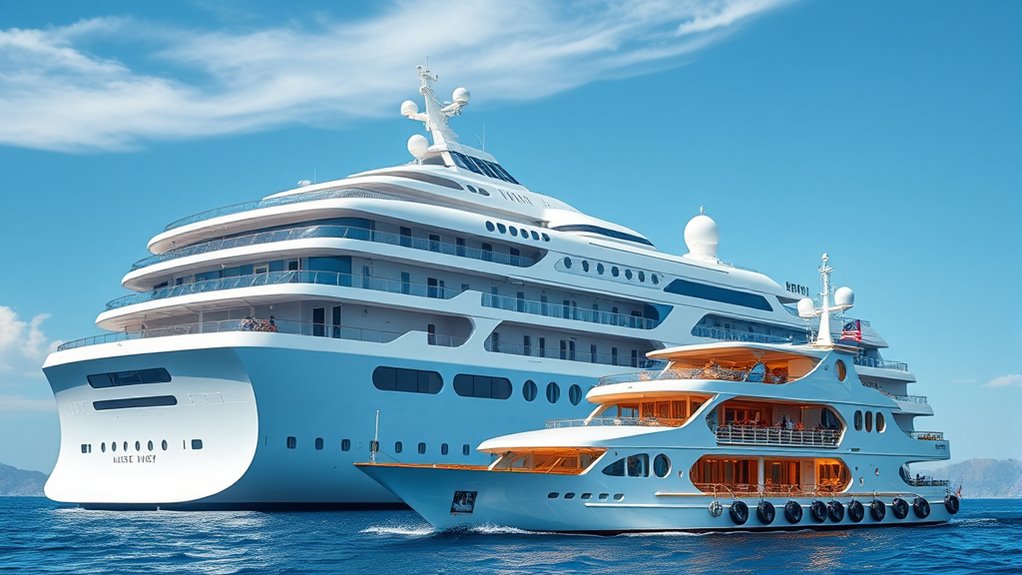
Large cruise ships offer a wide array of accommodation options and dining styles designed to cater to diverse guest preferences. With numerous dining options, including formal main dining rooms, buffets, specialty restaurants, and room service, you enjoy a varied culinary experience. Large cruise ships typically feature structured service styles with fixed meal times and reservation systems, accommodating hundreds of passengers at once. In contrast, small ships usually have fewer dining venues, often with a single main dining room that emphasizes high-quality, locally inspired cuisine. They provide a more intimate, relaxed atmosphere with flexible, casual dining options. Whether you prefer the variety and convenience of large ships or the personalized, authentic culinary experience on small ships, your dining experience is tailored to your style.
Shore Excursions and Group Dynamics
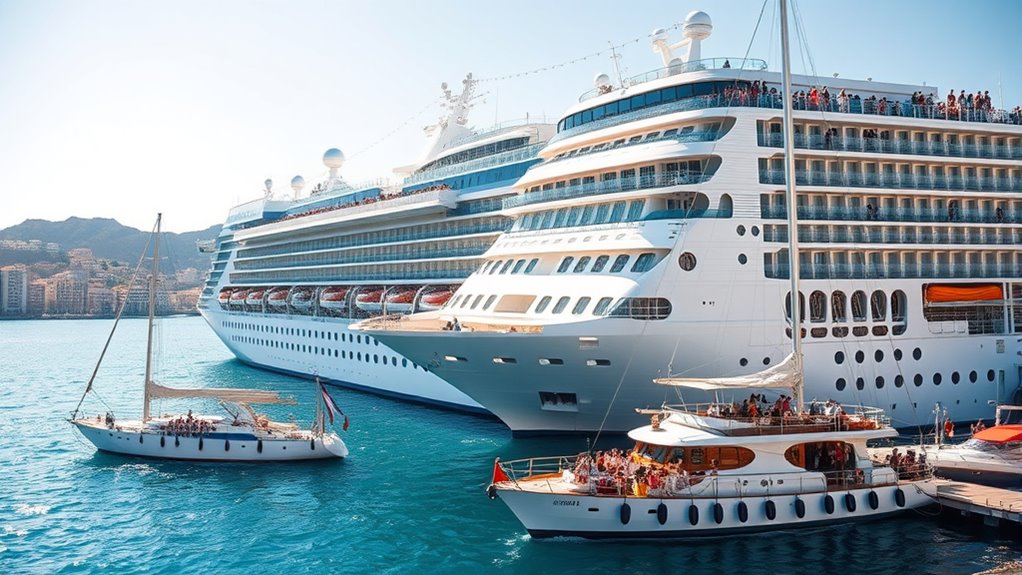
When choosing between big and small ships, consider how tour size and personalization impact your experience. Small ships offer more intimate excursions and access to unique ports, while large ships typically provide organized, larger-group tours at popular destinations. Your preferences for flexibility and authentic cultural encounters will help determine which approach suits you best.
Tour Size and Personalization
Have you ever noticed how shore excursions differ markedly depending on the size of the cruise ship? Small ships offer a more personalized service, with smaller tour sizes that create intimate experiences. These ships often dock in remote ports, giving you access to unique land adventures unavailable to larger vessels. On small ships, shore excursions are typically led by expert guides who provide in-depth cultural and wildlife insights, enhancing your experience. Group dynamics on these vessels foster closer social interactions, making the journey more engaging. In contrast, large ships tend to organize mass-market tours with big groups, which can limit individual attention and flexibility. Overall, the tour size and personalized service on small ships create a more memorable, tailored exploration of your destinations.
Port Access and Variety
Ever wonder how ship size influences your port experiences? Small ships typically dock closer to city centers and key attractions, giving you easier port access and more authentic shore excursions. Large ships often anchor farther from ports, requiring extra transportation and limiting access to smaller or remote destinations. With small ships, you can explore a wider variety of destinations, including lesser-known ports and narrow waterways inaccessible to larger vessels. Shore excursions on small ships tend to be more personalized, with smaller groups and tailored activities, making your experience more relaxed and immersive. In contrast, big ships usually rely on crowded, bus-based tours. Overall, small ships offer greater port access and a richer variety of destinations, enhancing your exploration and adventure.
Itineraries and Onboard Activities
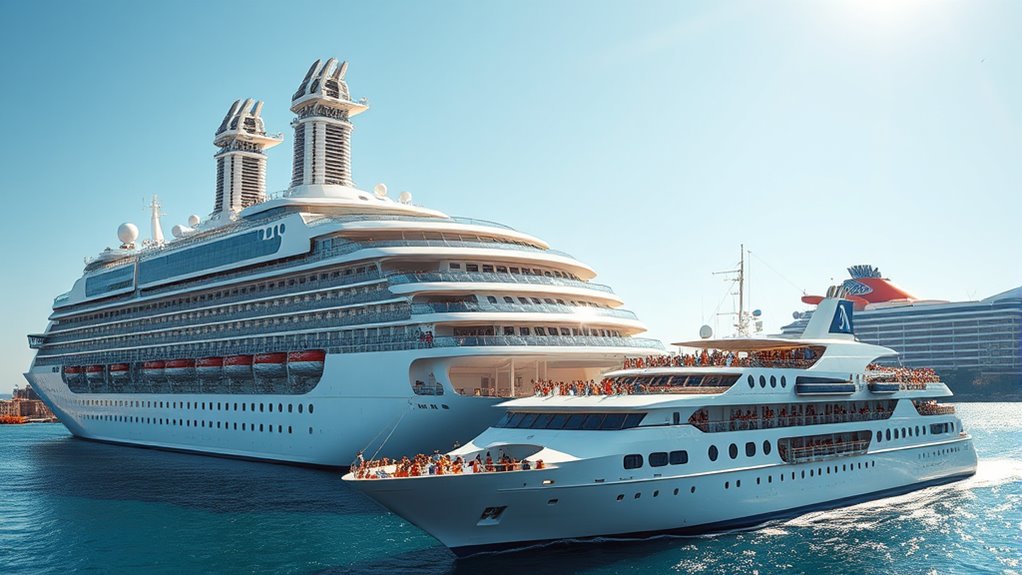
Big ships usually stick to fixed itineraries, with scheduled port visits and a wide range of onboard activities like shows, casinos, and pools that keep you entertained throughout the voyage. This structure guarantees you experience popular destinations with organized shore excursions and plenty of entertainment options onboard. In contrast, small ships offer flexible itineraries, allowing spontaneous changes based on weather or passenger interests, emphasizing destination exploration and cultural immersion. You can enjoy activities like guided walks, wildlife observation, or visits to hidden ports.
- Big ships: scheduled port visits, organized shore excursions, large-scale entertainment
- Small ships: flexible itineraries, personalized experiences, intimate explorations
- Activities: onboard entertainment, destination-specific experiences, cultural discovery
Family Amenities and Overall Atmosphere
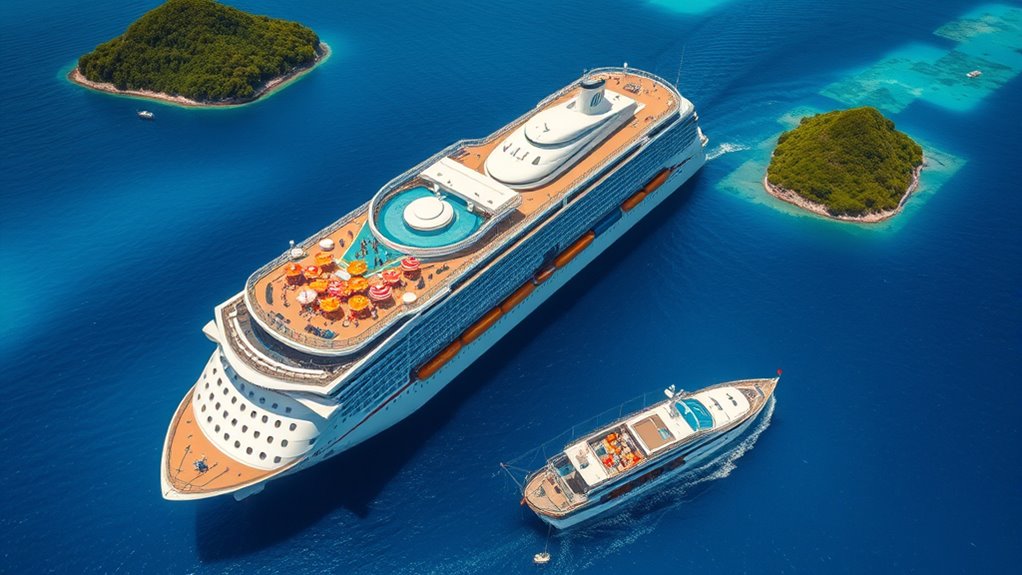
Large ships create a lively, family-friendly atmosphere with extensive amenities like water parks, arcades, and dedicated kids’ clubs that keep children entertained and engaged throughout the voyage. These big ships are designed with family amenities that enhance the passenger experience, offering diverse entertainment options such as Broadway-style shows and themed character areas. Children’s facilities are a key feature, ensuring kids have a fun, safe environment while parents relax. In contrast, small ships tend to focus on adult-oriented, cultural experiences with fewer or no dedicated children’s facilities, resulting in a quieter, more intimate atmosphere. Overall, big ships create an energetic, entertainment-rich environment ideal for families, while small ships prioritize tranquility and personalized service over family-oriented features.
Frequently Asked Questions
What Is the Difference Between Big Cruise Ships and Small Cruise Ships?
You’re curious about the difference between big and small cruise ships. With big ships, you get an energetic atmosphere, tons of amenities, and lots of fellow travelers, but boarding can take longer. Small ships offer a more intimate experience, quicker boarding, and access to remote destinations. You’ll enjoy personalized service, a relaxed vibe, and the chance to explore places larger ships can’t reach, making your trip more exclusive.
What Are the Advantages of Small Cruise Ships?
You’ll find that small cruise ships offer a more intimate and personalized experience. With fewer passengers, you get quicker boarding and disembarking, plus less congestion. They can access remote ports, giving you authentic and exclusive adventures. The relaxed atmosphere and attentive crew create a refined environment perfect for meaningful social interactions. Plus, you enjoy unique shore excursions that are often more immersive and less commercialized, making your journey truly special.
What Are the Advantages of Larger Ships?
Imagine you’re stepping onto a floating city, like the Titanic of the modern era. Larger ships let you enjoy a wide variety of amenities, from specialty restaurants to Broadway-style shows, all in one place. You can try water parks, rock climbing, or zip lining, making your trip exciting. Although it can get crowded, the sheer range of activities and entertainment guarantees there’s never a dull moment on a big ship.
What Are the Key Differences Between River Cruises and Ocean Cruises Who Are the Target Markets for These Cruises?
When choosing between river and ocean cruises, you should consider their target markets. River cruises appeal to mature travelers who want cultural immersion, scenic views, and a relaxed atmosphere, often exploring historic cities up close. Ocean cruises attract a broader audience, including families and adventure seekers, offering extensive itineraries, diverse entertainment, and onboard amenities. Your preferences for intimacy, destinations, and activities will guide you to the right cruise type.
Conclusion
Whether you prefer the intimate charm of a small ship or the vibrant energy of a big cruise, there’s a perfect fit for everyone. Don’t let concerns about limited amenities hold you back—imagine cozy lounges, personalized service, and authentic experiences that big ships might overlook. Whichever you choose, you’ll create unforgettable memories, exploring new destinations with ease and comfort. So, go ahead—embark on your adventure and discover the cruise that feels just right for you.

